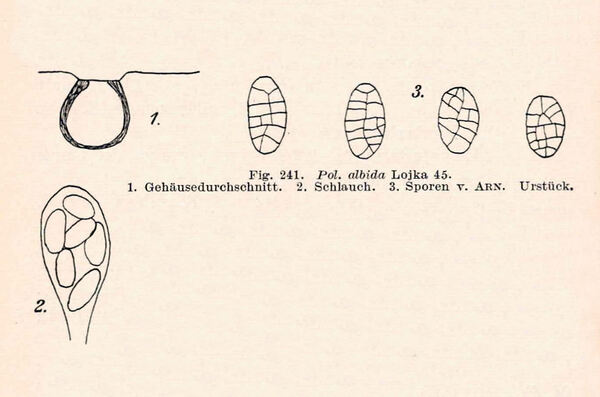Polyblastia albida Arnold
Flora, 41: 551, 1858.
Synonyms: Polyblastia circularis Blomb. ex T. Fr.
Distribution: N - Frl, Ven, TAA (Nascimbene & al. 2007b, 2022), Piem (Isocrono & al. 2004). C - Marc (Nimis & Tretiach 1999), Umb (Genovesi & Ravera 2001, Ravera & al. 2006), Abr (Cucchi & al. 2009, Gheza & al. 2021). S - Camp (Garofalo & al. 1999, 2010, Aprile & al. 2003b), Cal (Nimis & Puntillo 2003, Puntillo 2011).
Description: Thallus crustose, endosubstratic, continuous, whitish, smooth to rugose, often inapparent; deeper parts of thallus often with globose, up to 7 μm thick oil-cells. Perithecia numerous, black, globose, 0.2-0.4 mm across, completely immersed and leaving pits in the rock, visible as black dots corresponding to the flattened periostiolar region. Involucrellum absent; exciple globose, dark throughout, slightly thicker in the apical part; hamathecium of periphyses and periphysoids, interascal filaments absent; hymenial gel hemiamyloid, I+ red (I+ blue at very low concentrations of I), K/I+ blue. Asci 8-spored, clavate, K/I-, fissitunicate, the wall thickened above, with an ocular chamber, dehiscent by extrusion of an endotunica to form a delicate rostrum. Ascospores submuriform to muriform, with 4-8 transverse septa and 2-3(-4) longitudinal septa, hyaline, ellipsoid to subglobose, (16-)21-45(-52) x (10-)12-22(-28) μm. Photobiont chlorococcoid. Spot tests: K-, C-, KC-, P-, UV-. Chemistry: without lichen substances.Note: on hard calciferous rocks and dolomite in sheltered situations, also within forests; frequent in the Alps, much rarer in the Apennines, where it is confined to high altitudes.
Growth form: Crustose endolithic
Substrata: rocks
Photobiont: green algae other than Trentepohlia
Reproductive strategy: mainly sexual
Commonnes-rarity: (info)
Alpine belt: rare
Subalpine belt: rather rare
Oromediterranean belt: very rare
Montane belt: rather rare
Submediterranean belt: absent
Padanian area: absent
Humid submediterranean belt: absent
Humid mediterranean belt: absent
Dry mediterranean belt: absent
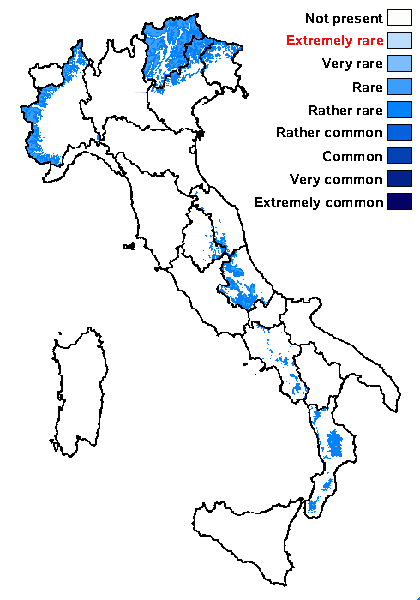
Predictive model
Herbarium samples
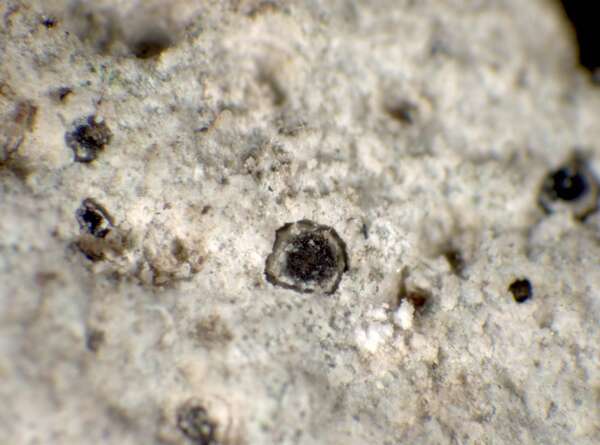

P.L. Nimis; Owner: Department of Life Sciences, University of Trieste
Herbarium: TSB (24224)
2001/12/12
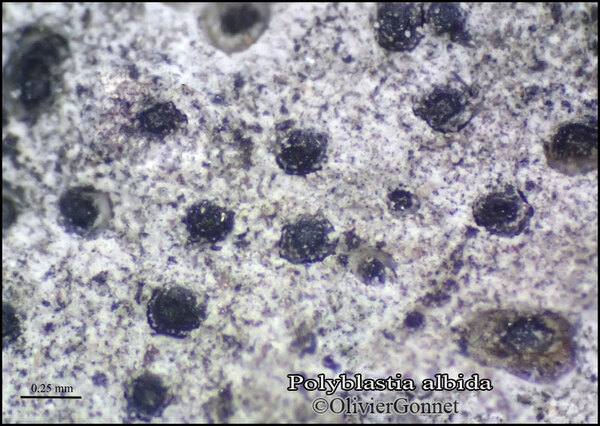
Courtesy Danièle et Olivier Gonnet - Source: https://www.afl-lichenologie.fr/Photos_AFL/Photos_AFL_P/Text_P_4/Polyblastia_albida.htm
France, 18/5/2015 - Salignac-Eyvigues - Dordogne
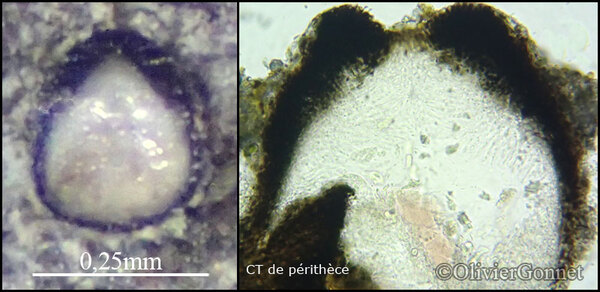
Courtesy Danièle et Olivier Gonnet - Source: https://www.afl-lichenologie.fr/Photos_AFL/Photos_AFL_P/Text_P_4/Polyblastia_albida.htm
France, 18/5/2015 - Salignac-Eyvigues - Dordogne
Growth form: Crustose endolithic
Substrata: rocks
Photobiont: green algae other than Trentepohlia
Reproductive strategy: mainly sexual
Commonnes-rarity: (info)
Alpine belt: rare
Subalpine belt: rather rare
Oromediterranean belt: very rare
Montane belt: rather rare
Submediterranean belt: absent
Padanian area: absent
Humid submediterranean belt: absent
Humid mediterranean belt: absent
Dry mediterranean belt: absent

Predictive model
| Herbarium samples |


P.L. Nimis; Owner: Department of Life Sciences, University of Trieste
Herbarium: TSB (24224)
2001/12/12

Courtesy Danièle et Olivier Gonnet - Source: https://www.afl-lichenologie.fr/Photos_AFL/Photos_AFL_P/Text_P_4/Polyblastia_albida.htm
France, 18/5/2015 - Salignac-Eyvigues - Dordogne

 Index Fungorum
Index Fungorum
 GBIF
GBIF

